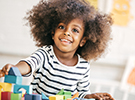Fire Truck Fun
In this lesson, children will make connections between the pre-drawn shapes of a fire truck and the shapes of various snack items.
Lesson for:
Toddlers/Preschoolers
(See Step 5: Adapt lesson for toddlers or preschoolers.)
Content Area:
Geometry
Learning Goals:
This lesson will help toddlers and preschoolers meet the following educational standards:
- Analyze characteristics and properties of two- and three- dimensional geometric shapes and develop mathematical arguments about geometric relationships
- Apply transformations and use symmetry to analyze mathematic situations
- Use visualization, spatial reasoning and geometric modeling to solve problems
Learning Targets:
After this lesson, toddlers and preschoolers should be more proficient at:
- Recognizing, naming, building, drawing, comparing and sorting two- and three-dimensional shapes
- Describing attributes and parts of two- and three-dimensional shapes
- Recognizing and applying slides, flips and turns
- Recognizing and representing shapes from different perspectives

Fire Truck Fun
Lesson plan for toddlers/preschoolers
Step 1: Gather materials.
- A variety of snacks for fire engine parts (Oreos for the wheels, graham crackers for the body, small pretzel sticks for the ladder, licorice string for the hoses, red and/or green gum drops for the flashing lights and shredded wheat rectangles for the cab of the truck work well, but you can make the fire truck shapes out of any food that you choose.)
- A large picture of a fire truck (download here)
- Paper that has all of the parts of the truck labeled according to shape so that the children can place their snacks on the appropriate geometric shapes.
Note: Small parts pose a choking hazard and are not appropriate for children age five or under. Be sure to choose lesson materials that meet safety requirements.
Step 2: Introduce activity.
- Review basic shapes (circle, square and rectangle).
- Show the picture of the fire engine to the children. Have them point out the different shapes that they see embedded in the fire truck.
- Explain that the children are going to create their own fire trucks out of different kinds of snack foods.
Step 3: Engage children in lesson activities.
- Show the children the variety of snacks and the fire truck paper. Explain that they will first make a fire truck using their snacks and then they can eat their fire trucks.
- Allow the children to put the shaped snacks onto the fire trucks. After the fire truck shapes have been filled, let the children eat their snacks.
Additional Extensions
- Let the children’s creativity flow. Allow the children to construct the fire truck without the template.
Step 4: Vocabulary.
- Circle: A round shape that has no straight edges or corners (e.g.,”The wheels of the fire trucks are circles.”)
- Rectangle: A shape with four sides (two long and two short) and four corners (e.g.,”The body of the fire truck is a rectangle.”)
- Square: A shape with four straight sides that are the same length or size and four corners (e.g.,”The cab of the fire truck is a square.”)
Step 5: Adapt lesson for toddlers or preschoolers.
Adapt Lesson for Toddlers
Toddlers may:
- Have difficulty placing the correctly shaped snack onto the template
Child care providers may:
- Help the children place the shaped snacks onto the shapes on the template
- Simplify the template and have the children work with one shape at a time
Adapt Lesson for Preschoolers
Preschoolers may:
- Be able to match the shaped food with the corresponding shapes on the templates
Child care providers may:
- Let the children’s creativity flow. Allow the children the construct the fire truck without the template.
Suggested Books
- Shape by Shape by Suse MacDonald (New York: Little Simon, 2009)
- The Shape of Things to Come by Dale Ann Dodds (New York: Turtleback Books, 1996)
- Mouse Shapes by Ellen Toll Walsh (New York: Houghton Mifflin Harcourt, 2007)
Music and Movement
- “Basic Shapes”
- “Shape Up” by Jack Harttman
- “I Spy Attributes” by Ron Brown
Outdoor Connections
- Have the children build other objects out of found materials. You can create a template that the children can match their found objects to or tell the children to construct their own objects out of found materials. It might be hard for the children to find objects that are shaped like the circles, rectangles and squares on the template, so you may need to provide objects for the children to use.
Web Resources
- “Purpy’s Shapes” Children help Purpy (a purple circle) find his favorite shapes.
Comment on this lesson